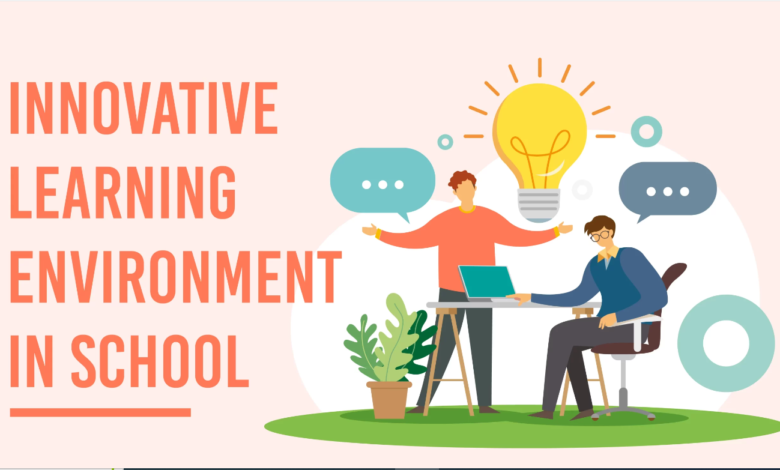
How Would You Create an Innovative Learning Environment: Beneficial Tips for You
To create an innovative learning environment, focus on practical learning over rote memorization, foster a change in mindset, encourage self-evaluation, facilitate open-ended questions, create a inclusive space, develop problem-solving skills, and encourage risk-taking and learning from failures. Creating an innovative learning environment is crucial to foster creativity, critical thinking, and a love for learning among students.
Traditional teaching methods that rely on rote memorization and passive learning are no longer sufficient in preparing students for the complexities of the modern world. Instead, educators need to embrace a new mindset that emphasizes practical learning, self-evaluation, and problem-solving skills.
This can be achieved by encouraging open-ended questions, creating an inclusive space where all students can thrive, and teaching students to take risks and learn from failures. By implementing these strategies, educators can create an environment that nurtures innovation and prepares students for success in the rapidly changing global landscape.
Contents
Exploring Innovative Learning Environments
To create an innovative learning environment, focus on practical learning over rote methods. Foster a mindset shift, encourage self-evaluation, and promote problem-solving skills. Embrace open-ended questions, inclusivity, risk-taking, and learning from failures. Adapt the classroom for flexible, productive, and collaborative experiences.
The Importance Of Innovation In Education
In this fast-paced and ever-changing world, innovation is the key to success in all fields, including education. The traditional methods of teaching and learning are no longer sufficient to prepare students for the future. The incorporation of innovative approaches in education not only enhances student engagement, but also fosters critical thinking, problem-solving skills, and creativity. In an innovative learning environment, students are encouraged to explore, experiment, and collaborate, enabling them to become lifelong learners who can adapt to the dynamic challenges of the modern world.
Characteristics Of An Innovative Learning Environment
An innovative learning environment is characterized by several key elements:
1. Flexibility: The physical space and curriculum should be designed in a way that allows for flexibility and adaptability. This includes the use of versatile furniture, technology integration, and the ability to modify the learning environment based on the needs and interests of the students.
2. Collaboration: Collaboration is a crucial aspect of an innovative learning environment. Students should be encouraged to work together, share ideas, and solve problems collectively. This promotes teamwork, communication skills, and the ability to think critically from multiple perspectives.
3. Technology Integration: Technology plays a vital role in an innovative learning environment. By incorporating various digital tools and resources, students can access information, engage in interactive learning activities, and develop digital literacy skills that are essential in today’s digital age.
4. Student-centered Approach: In an innovative learning environment, the focus is on the student. Teachers act as facilitators, guiding students’ learning journeys and tailoring instruction to meet individual needs and preferences. Personalized learning experiences empower students to take ownership of their education and develop a love for lifelong learning.
5. Continuous Learning: Innovation in education entails a mindset of continuous learning and growth. This involves encouraging students to take risks, embrace challenges, and learn from failures. By fostering a growth mindset, students develop resilience, perseverance, and a willingness to embrace new ideas and concepts.
6. Real-World Connections: An innovative learning environment bridges the gap between the classroom and the real world. Students should be given opportunities to apply their learning in authentic contexts and engage with real-world problems. This fosters critical thinking skills and enables students to see the practical applications of their knowledge.
7. Creativity and Innovation: Finally, an innovative learning environment nurtures creativity and innovation. Students should be encouraged to think creatively, explore multiple solutions, and develop innovative ideas. This involves incorporating project-based learning, problem-solving activities, and opportunities for self-expression. By creating an innovative learning environment that encompasses these characteristics, educators can empower their students to become confident, independent thinkers who are prepared to thrive in an ever-evolving world.

Credit: www.betterup.com
Keys To Creating An Innovative Learning Environment
Creating an innovative learning environment is essential to foster creativity and critical thinking among students. To achieve this, certain key elements must be incorporated. These include embracing mindset change, promoting self-reflection, and establishing flexible learning spaces.
Embracing Mindset Change
Embracing mindset change is crucial to creating an innovative learning environment. A shift in mindset allows for a more open and receptive approach to learning. Educators should encourage students to challenge conventional thinking and explore new ideas. By embracing a growth mindset, students are more inclined to take risks, learn from failures, and develop problem-solving skills.
Promoting Self-reflection
Promoting self-reflection is another key aspect of creating an innovative learning environment. Students should be encouraged to reflect on their learning experiences, identify areas of improvement, and set goals for themselves. This self-awareness fosters a deeper understanding of their strengths and weaknesses, allowing them to take ownership of their learning journey.
Establishing Flexible Learning Spaces
Establishing flexible learning spaces is essential for promoting collaboration, creativity, and adaptability among students. Classrooms should be designed in a way that allows for different learning styles and preferences. This can include creating comfortable seating arrangements, incorporating technology, and providing access to various learning resources. By offering a flexible learning environment, educators can cater to the diverse needs of their students.
Strategies For Encouraging Innovation In The Classroom
- Practical learning over rote learning sparks creativity and critical thinking in students.
- Encouraging open-ended questions cultivates curiosity and problem-solving skills.
- Developing a problem-finding approach and resilience through risk-taking enhances innovation.

Credit: www.amazon.com
Enhancing Student Engagement And Risk-taking
Enhancing student engagement and risk-taking in an innovative learning environment can be achieved by focusing on practical learning, encouraging open-ended questions, and developing problem-solving skills. By creating a supportive space where students can take risks and learn from failures, educators can foster a culture of innovation and growth.
Encouraging Interaction And Collaboration
In an innovative learning environment, encouraging students to interact and collaborate is vital. By facilitating group projects, peer discussions, and team-based activities, students can develop critical thinking and communication skills. This collaborative approach can also foster a sense of community and mutual learning among students.
Teaching Risk-taking And Learning From Failures
To promote risk-taking and learning from failures, educators can create an atmosphere that embraces experimentation and creativity. Encouraging students to explore unconventional solutions and challenging them to push boundaries fosters a culture that welcomes trial and error. Additionally, teachers should emphasize the value of learning from mistakes, thereby encouraging resilience and persistence.
Supporting Innovation Through Teaching Practices
In an innovative learning environment, teaching practices play a crucial role in fostering creativity, critical thinking, and problem-solving skills among students. Through effective teaching practices, positive relationships can be built, high academic expectations can be set, and collaboration can be encouraged, all of which are essential for nurturing innovation.
Building Positive Relationships
Maintaining positive relationships with students is key to supporting innovation in the classroom. By establishing a supportive and inclusive atmosphere, teachers can create a safe space for students to express their ideas, take risks, and explore new concepts without fear of judgment. This can be achieved through active listening, empathy, and individualized support, helping students to feel valued and motivated to engage with the learning process.
Setting High Academic Expectations
Setting high academic expectations is essential for challenging students to reach their full potential and fostering an environment of continuous improvement. By encouraging students to aim for excellence and providing them with the necessary resources and support to succeed, teachers can inspire a culture of ambition, perseverance, and achievement. This can result in students pushing their boundaries and thinking innovatively to meet and exceed these expectations.
Encouraging Collaboration
Encouraging collaboration among students creates an environment where diverse perspectives, ideas, and skills can converge to generate innovative solutions. Through activities that promote teamwork, communication, and collective problem-solving, students can learn from one another and develop a deeper understanding of the subject matter. By fostering a sense of collective responsibility and mutual support, teachers can cultivate an atmosphere where innovation thrives through the exchange and development of ideas.
Frequently Asked Questions
How Could We Create An Innovative Learning Environment?
To create an innovative learning environment, focus on practical learning, promote a change in mindset, encourage self-evaluation, ask open-ended questions, create an inclusive space, develop problem-solving skills, teach students to take risks and learn from failures.
How Would You Create An Innovative 1 Learning Environment?
To create an innovative learning environment, focus on practical learning, promote a mindset change, encourage self-evaluation, ask open-ended questions, ensure inclusivity, develop problem-solving skills, and teach risk-taking. This approach fosters creativity and adaptability in students.
How Can You Create A Learning Environment?
To create a learning environment: Emphasize practical learning, change mindset, encourage self-evaluation, promote open-ended questions, accommodate all learners, foster problem-solving skills, teach risk-taking and resilience. Build positive relationships, arrange a conducive physical space, set high expectations, provide reinforcement, seek feedback, encourage collaboration, and utilize current teaching methods.
What Are Innovative Learning Environments?
Innovative learning environments support future-focused teaching and learning, providing flexibility, agency, ubiquity, and connectedness. These environments evolve and adapt to changing educational practices, encouraging a thoughtful learning process. Encourage practical learning, open-ended questions, mindset change, and problem-solving skills to create an innovative learning environment.
Conclusion
Innovative learning environments foster growth through practical engagement, mindset shift, and problem-solving skills. Encouraging risk-taking and collaboration alongside personalized support enhances student development. By embracing change and fostering creativity, we can cultivate dynamic educational spaces that empower learners for future success.



